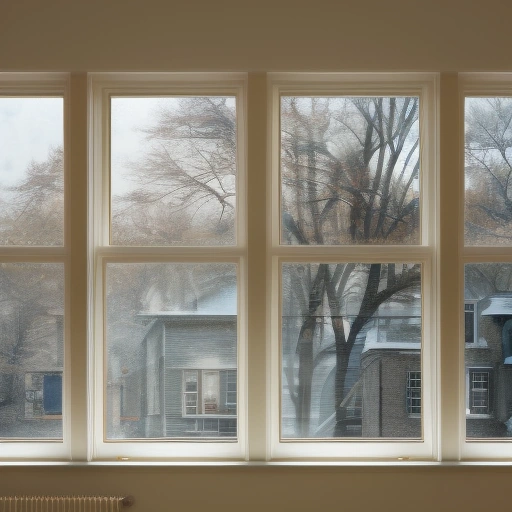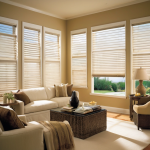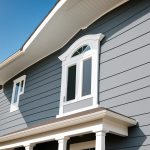Top 7 Energy-Efficient Windows for Homes in New York: Reducing Winter Heating Bills in 2025
Battling the Big Apple Chill: The Quest for Energy-Efficient Windows
As the biting winds of winter sweep across New York, homeowners are bracing for another season of escalating heating costs. But what if you could significantly reduce those bills without sacrificing comfort or style? The answer lies in energy-efficient windows. By 2025, advancements in window technology have made it easier than ever to find windows that not only enhance your home’s aesthetic appeal but also dramatically improve its energy performance. This article delves into the top 7 energy-efficient window options available to New York homeowners, offering a comprehensive guide to saving money and staying warm throughout the winter months.
For New York homeowners, the urgency to upgrade to energy-efficient windows extends beyond mere comfort; it’s a strategic investment in their property’s value and a commitment to sustainable living. In the competitive New York real estate market, homes equipped with modern, energy-efficient features command higher prices and attract environmentally conscious buyers. Window replacement projects, therefore, are not just about reducing winter heating bills; they represent a significant home improvement that enhances curb appeal and contributes to a healthier, more sustainable lifestyle.
The city’s unique architectural landscape, from historic brownstones to modern high-rises, demands window solutions that blend seamlessly with existing aesthetics while delivering optimal energy savings. The financial incentives for investing in energy-efficient windows in New York are also becoming increasingly compelling. Utility companies often offer rebates and tax credits for homeowners who install energy-saving upgrades, further offsetting the initial cost of window replacement. Moreover, the long-term energy savings can be substantial, particularly in older New York homes with poorly insulated windows.
Imagine the cumulative impact of reducing your heating bill by 20-30% each winter – that’s money back in your pocket, year after year. By strategically selecting windows with features like Low-E glass and insulated frames, homeowners can create a more comfortable and energy-efficient living environment, contributing to a more sustainable future for the city. Beyond the financial and environmental benefits, upgrading to energy-efficient windows enhances the overall comfort and quality of life for New York residents.
Drafty windows are a common source of discomfort during the winter months, leading to uneven temperatures and cold spots throughout the home. Energy-efficient windows, particularly triple-pane windows, provide superior insulation, creating a more consistent and comfortable indoor climate. Furthermore, these windows can significantly reduce noise pollution from the bustling city streets, creating a more peaceful and serene living environment. Investing in energy-efficient windows is therefore an investment in your home’s value, your comfort, and your well-being, making it a smart choice for any New York homeowner looking to improve their living space and reduce their environmental footprint.
1. Low-E Glass Windows: The Cornerstone of Energy Efficiency
Low-E glass windows are a cornerstone of energy-efficient homes, particularly crucial for New York homes battling harsh winters. These windows are engineered with a microscopically thin, transparent coating – often made of metallic oxides – that acts as a selective filter for solar radiation. This coating reflects infrared light (heat) while allowing visible light to pass through. The result is a window that keeps heat inside during the winter months, drastically reducing the need for excessive heating and thereby lowering winter heating bills.
Conversely, during the summer, Low-E coatings reflect solar heat away from the home, helping to maintain a cooler indoor temperature and reduce air conditioning costs. This dual-action capability makes Low-E glass a year-round asset for energy savings. In New York’s diverse climate, selecting the right Low-E coating is paramount. Look for windows with a low U-factor, which measures the rate of heat transfer; lower U-factors indicate better insulation. Simultaneously, consider the Solar Heat Gain Coefficient (SHGC), which measures how much solar radiation passes through the window.
For optimal performance in the winter, a higher SHGC can be beneficial, allowing more solar heat to enter the home. However, in sun-exposed southern-facing windows, a lower SHGC might be preferable to prevent overheating during the summer. Consulting with a window replacement specialist familiar with 2025 window technology and local climate conditions is highly recommended to determine the ideal Low-E coating for your specific needs. Beyond the U-factor and SHGC, the type of Low-E coating also matters.
Different Low-E coatings offer varying levels of performance and can be tailored to specific climate needs. For instance, some Low-E coatings are designed for maximum solar heat gain, while others prioritize blocking solar heat. Furthermore, the number of Low-E coatings applied to the glass can also impact performance. Double or even triple Low-E coatings offer enhanced energy efficiency, but also come with a higher price tag. Homeowners should carefully weigh the costs and benefits to determine the most cost-effective solution for their home insulation and energy savings goals. Investing in energy-efficient windows with appropriate Low-E coatings is not only a smart financial decision but also a step towards sustainable living and reducing your carbon footprint.
2. Triple-Pane Windows: Ultimate Insulation for Maximum Savings
Triple-pane windows represent a significant leap in energy efficiency for New York homes, offering an enhanced barrier against the relentless winter chill. Unlike their double-pane counterparts, triple-pane windows incorporate an additional layer of glass, creating two insulating air spaces typically filled with inert gases like argon or krypton. These gases, denser than air, dramatically reduce conductive heat transfer, meaning less heat escapes your home. While the initial investment is higher, the long-term energy savings and improved comfort levels often justify the cost, especially for homeowners acutely aware of escalating winter heating bills.
In the context of New York Real Estate, installing triple-pane windows can be a selling point, showcasing a commitment to sustainable living and reduced energy consumption. The superior insulation provided by triple-pane windows translates directly into lower energy consumption and reduced carbon footprint, aligning perfectly with the principles of sustainable living. Consider a brownstone in Brooklyn, where drafts are common and heating costs can be exorbitant. Replacing old, single-pane windows with energy-efficient triple-pane windows featuring Low-E glass can slash heating bills by as much as 30%, according to recent studies on 2025 window technology.
Moreover, the increased soundproofing offered by triple-pane windows is a major advantage in bustling urban environments, creating a quieter and more peaceful living space. This noise reduction contributes to the overall quality of life and can positively impact property values in desirable New York neighborhoods. Beyond energy savings and noise reduction, triple-pane windows contribute to improved home insulation and overall comfort. By minimizing heat loss in the winter and heat gain in the summer, these windows help maintain a more consistent indoor temperature, reducing the strain on your HVAC system.
This can extend the lifespan of your heating and cooling equipment, further contributing to long-term cost savings. Furthermore, the reduced condensation on the interior glass surface minimizes the risk of mold growth, promoting a healthier indoor environment. When considering window replacement options for New York homes, triple-pane windows should be a strong contender, particularly for those seeking maximum energy efficiency and a commitment to sustainable practices. As 2025 approaches, advancements in materials and manufacturing processes are making triple-pane windows more accessible and affordable, solidifying their position as a leading choice for energy-conscious homeowners.
3. Vinyl Windows: Affordable Efficiency and Lasting Durability
Vinyl windows have cemented their position as a go-to choice for New York homes seeking a balance of affordability, durability, and energy efficiency. Modern advancements in vinyl window design have significantly enhanced their performance, making them a compelling option for homeowners looking to reduce winter heating bills. These energy-efficient windows are engineered with multiple air chambers within the frame, acting as a thermal break to minimize heat transfer. This design, coupled with insulated glass packages like Low-E glass coatings and argon gas fills, creates a formidable barrier against the harsh New York winters, preventing precious heat from escaping and keeping your home comfortable.
Furthermore, the inherent properties of vinyl make it resistant to rot, warping, and pest infestations, reducing long-term maintenance costs and headaches for busy homeowners. For New York real estate, this translates to increased property value and appeal to prospective buyers who prioritize energy savings and low upkeep. When selecting vinyl windows, it’s crucial to look for those with Energy Star certification. This certification ensures that the windows meet stringent energy performance standards set by the U.S.
Environmental Protection Agency, guaranteeing significant energy savings. In the context of 2025 window technology, Energy Star certified vinyl windows often incorporate features like Low-E coatings specifically formulated for northern climates and advanced weatherstripping to minimize air leakage. Furthermore, consider the window’s U-factor and Solar Heat Gain Coefficient (SHGC). A lower U-factor indicates better insulation, while the optimal SHGC depends on the window’s orientation; south-facing windows might benefit from a higher SHGC to capture solar heat during the winter, while east- and west-facing windows may require a lower SHGC to prevent overheating in the summer.
Understanding these factors will help you maximize energy savings and comfort in your New York home. Beyond energy performance, the sustainable living aspect of vinyl windows is also noteworthy. Modern vinyl window manufacturing processes are increasingly focused on reducing waste and utilizing recycled materials. Many manufacturers now offer vinyl windows made with a significant percentage of recycled content, contributing to a more circular economy. While older vinyl formulations faced criticism regarding their environmental impact, advancements in material science have addressed many of these concerns. When considering window replacement, exploring the sustainability practices of the manufacturer can align your home improvement project with your environmental values. By choosing energy-efficient vinyl windows with recycled content and proper end-of-life recycling options, New York homeowners can contribute to a more sustainable future while enjoying lower winter heating bills and a more comfortable living environment.
4. Composite Wood Windows: The Perfect Blend of Beauty and Performance
Wood windows have long been prized for their inherent beauty and natural insulation capabilities, lending a touch of timeless elegance to New York homes. However, the realities of New York’s climate – from humid summers to harsh, snowy winters – often lead to the premature decay of traditional wood windows, necessitating frequent and costly maintenance. Composite wood windows offer a compelling solution, artfully merging the aesthetic appeal of natural wood with the robust durability of advanced synthetic materials.
These windows typically feature a wood core, often crafted from engineered wood for enhanced stability, encased in a weather-resistant cladding such as aluminum or fiberglass. This innovative construction provides excellent protection against moisture, insects, and temperature fluctuations, significantly extending the lifespan of the window and reducing the need for ongoing repairs. For homeowners seeking the warmth of wood without the associated upkeep, composite windows present a smart and sustainable choice, aligning with the growing demand for energy-efficient and low-maintenance home improvements in the New York real estate market.
The key advantage of composite wood windows lies in their ability to deliver exceptional energy efficiency while retaining the classic look that many homeowners desire. The wood core provides natural insulation, helping to minimize heat transfer during the winter months and keep homes cooler in the summer, directly contributing to lower winter heating bills. The exterior cladding, whether it’s aluminum or fiberglass, further enhances energy performance by creating a tight seal against air and water infiltration.
Many composite wood windows also incorporate Low-E glass coatings and gas fills like argon or krypton between the panes, boosting their insulation value even further. For example, a homeowner in Westchester County who replaced their old, drafty wood windows with composite wood windows featuring Low-E glass reported a 20% reduction in their annual energy bills. This makes composite wood windows a financially sound investment for New York homeowners looking to improve their home insulation and reduce their carbon footprint.
Furthermore, the sustainable aspects of composite wood windows make them an increasingly attractive option for environmentally conscious homeowners in New York. By utilizing engineered wood and durable cladding materials, these windows reduce the demand for old-growth timber and minimize waste associated with frequent window replacement. The extended lifespan of composite windows also translates to fewer resources consumed over time. When considering window replacement options in 2025, homeowners should prioritize products with certifications from organizations like the Forest Stewardship Council (FSC) and the National Fenestration Rating Council (NFRC) to ensure both environmental responsibility and verified energy performance. As New York continues to prioritize sustainable living and energy conservation, composite wood windows offer a harmonious blend of beauty, durability, and environmental stewardship, making them a valuable asset for any home.
5. Fiberglass Windows: Strength, Stability, and Energy Savings
Fiberglass windows are renowned for their exceptional strength, stability, and inherent energy efficiency, making them a compelling option for New York homes facing the challenges of fluctuating temperatures and demanding weather conditions. Unlike some other window materials, fiberglass exhibits remarkable resistance to warping, cracking, and fading, ensuring a long-lasting and aesthetically pleasing window solution. This durability translates to fewer replacements and reduced maintenance costs over the lifespan of the window, a significant consideration for New York homeowners focused on long-term value and home improvement investments.
Furthermore, the inherent strength of fiberglass allows for narrower frames, maximizing the glass area and providing more natural light, a desirable feature in the often-compact living spaces of New York City. This combination of durability and design flexibility positions fiberglass windows as a premium choice for discerning homeowners. One of the key advantages of fiberglass windows lies in their low thermal expansion rate, which closely matches that of glass. This compatibility minimizes stress on the window seals and frames, preventing air leaks that can significantly impact winter heating bills.
In contrast to materials like vinyl, which expand and contract considerably with temperature changes, fiberglass maintains its structural integrity, ensuring a consistently tight seal against the elements. This is particularly crucial in New York, where extreme temperature swings can put a strain on building materials. By minimizing air leakage, fiberglass windows contribute to superior home insulation and reduced energy consumption, aligning with sustainable living principles and contributing to a more comfortable and energy-efficient home environment.
Consider pairing fiberglass frames with Low-E glass or even triple-pane options to further enhance energy savings and comfort. While fiberglass windows may represent a higher initial investment compared to vinyl windows, their superior durability, long-term performance, and contribution to energy savings often justify the added cost. For New York real estate, the installation of energy-efficient fiberglass windows can increase property value and appeal to environmentally conscious buyers. Moreover, the reduced need for frequent window replacement translates to less waste and a smaller environmental footprint, aligning with the growing demand for sustainable building practices. Homeowners should explore available rebates and incentives for energy-efficient window replacement to further offset the initial cost and maximize the long-term benefits of choosing fiberglass windows for their New York homes. As 2025 window technology continues to evolve, fiberglass windows are poised to remain a top contender for homeowners seeking a balance of performance, aesthetics, and sustainability.


